A Museum for Melaleuca
It seemed a good idea when Friends of Melaleuca was offered the opportunity to take over the Deny King Bird Observation Hide as a space to house a small museum. Because of the increasing vulnerability of the end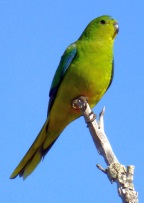 angered Orange-bellied parrot, the bird monitoring program was moved to a location further away from the busy airstrip and inc
angered Orange-bellied parrot, the bird monitoring program was moved to a location further away from the busy airstrip and inc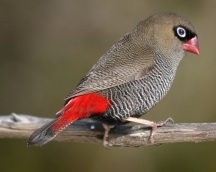 reasing visitor activity. This left the building vacant apart from a few interpretation panels, while pilots leading sight-seeing trips were left wondering how to entertain their tourists on a wet day!
reasing visitor activity. This left the building vacant apart from a few interpretation panels, while pilots leading sight-seeing trips were left wondering how to entertain their tourists on a wet day!
For those who have not visited this site, Melaleuca, in far southwest Tasmania, was a small tin-mining settlement from the 1930s until recent years when the tin field was assumed into the National Park and WWHA. The last tin miners were the King and Willson families, who still retain crown leaseholds at their residences.
No roads access Melaleuca. This was no doubt the most significant factor shaping the way of life for those who lived and worked at Melaleuca in the past. Even today, volunteers and PWS staff face difficulties of access. Light aircraft and freight by sea are subject to the vagaries of wild weather in the ‘Roaring Forties’, but such challenges contribute to the unique character of this place. It’s akin to being on an island. Thus members of Friends of Melaleuca feel a certain affinity with the Friends of Maatsuyker, Tasman and Deal Islands.
Our Ranger in Charge, Ian Marmion, suggested that the building be re-named the Deny King Heritage Museum. It is rather a pretty building, located between the Bathurst Harbour Landing gro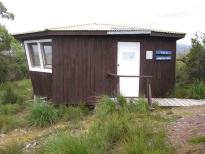 und (a white quartz gravel airstrip) and the Kings’ residence, and was erected by PWS in 1990. Unusually, it is a nine-sided structure, with the roof in triangular sections sloping down from a central supporting pole. The interior is divided by a partition wall, the eastern half having windows with a mountain view to the east and tin mine area to the south. The only window in the western half is a skylight, making this an ideal area for display cabinets and information panels.
und (a white quartz gravel airstrip) and the Kings’ residence, and was erected by PWS in 1990. Unusually, it is a nine-sided structure, with the roof in triangular sections sloping down from a central supporting pole. The interior is divided by a partition wall, the eastern half having windows with a mountain view to the east and tin mine area to the south. The only window in the western half is a skylight, making this an ideal area for display cabinets and information panels.
The mining of the past has left a rich heritage of objects and stories. We plan to extend interpretation of this beyond the museum walls to a mining trail taking in old mine structures and machinery. Changing mining t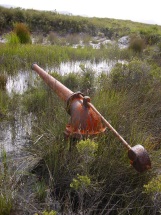 echniques will be documented in the museum itself, as well as remote are
echniques will be documented in the museum itself, as well as remote are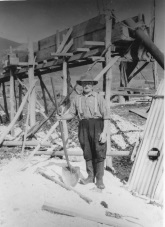 a living, subjects barely touched on to date in any interpretation for the public. There is a broader view of history that could be addressed in the museum too (subject to available space), covering aspects of the past from the early huon-pine cutters and whalers of Port Davey to aviation and boating adventures. The natural heritage of the area provides plenty of scope with landscape features such as peat mounds, and the influence of weather and geology on the button-grass moorland sedge complex and its associated fauna. And of course the Orange-bellied parrot.
a living, subjects barely touched on to date in any interpretation for the public. There is a broader view of history that could be addressed in the museum too (subject to available space), covering aspects of the past from the early huon-pine cutters and whalers of Port Davey to aviation and boating adventures. The natural heritage of the area provides plenty of scope with landscape features such as peat mounds, and the influence of weather and geology on the button-grass moorland sedge complex and its associated fauna. And of course the Orange-bellied parrot.
With no road access, who will view the museum? Tourists from many walks of life visit during sight-seeing flights, and in summer a number of other small tourist ventures operate in the area. Many yachts sail to Port Davey, the crews often coming up-river to Melaleuca, while bushwalkers begin their trips at Melaleuca almost daily in the season. In short, the audience is already there.
Our group has been inspired by the efforts of Friends of Maatsuyker Island who have documented the heritage objects on the island, and also by Friends of Deal Island who recently established the Kent Group Museum.
Establishing a museum is no easy matter. The task ahead looms larger and appears more daunting when realities are addressed. For us, some of the challenges ahead are a factor of Melaleuca’s remote location. How do we transport glass display cases there, for instance? We are investigating having knock-down plexi-glass cases made to order. But first we must measure the objects to ascertain appropriate sizes for cases. Fluctuating temperatures and high humidity pose a challenge for the conservation o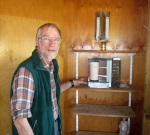 f objects on long-term exhibition, while security in an unattended building also presents food for thought. Transport (of both volunteers and freight) is a major expense, accounting for 36% of our projected $34,000 up-front costs. On top of this, we have estimated $31,600 for in-kind support including volunteer labour that will be required. Fundraising efforts have so far been directed at seeking corporate sponsorship from the minin
f objects on long-term exhibition, while security in an unattended building also presents food for thought. Transport (of both volunteers and freight) is a major expense, accounting for 36% of our projected $34,000 up-front costs. On top of this, we have estimated $31,600 for in-kind support including volunteer labour that will be required. Fundraising efforts have so far been directed at seeking corporate sponsorship from the minin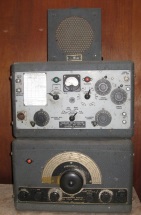 g sector, and three companies have been generous, but we still have a long way to go.
g sector, and three companies have been generous, but we still have a long way to go.
We have met with much interest and enthusiastic support for the museum idea. The Tasmanian Museum and Art Gallery and the Maritime Museum of Tasmania are supporting the project with staff time and expertise. Three museum experts from these institutions made a site visit to Melaleuca in November 2013 to get the planning process underway. Guy Greener (Huon Drafting) volunteered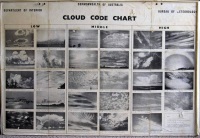 his time and expertise (including a site visit, tape measure in hand) to draw up plans for an entry porch. Parks and Wildlife Service has also been supportive and helpful, and an MOU has been signed for use of the building. Arts Tasmania has given helpful advice, as has consultant Chris Tassell. And we are fortunate to have considerable expertise within our own group.
his time and expertise (including a site visit, tape measure in hand) to draw up plans for an entry porch. Parks and Wildlife Service has also been supportive and helpful, and an MOU has been signed for use of the building. Arts Tasmania has given helpful advice, as has consultant Chris Tassell. And we are fortunate to have considerable expertise within our own group.
So far we have little on site to show for the project! There is, however, a large and expanding file of paperwork representing many hours of planning. Work on the ground commenced in March with PWS starting on the building of the entry porch. This was taken to floor level, but a further bout of building in May 2015 was postponed until spring on account of wet weather. Then we need to consider insulating the ceiling. Meanwhile we volunteers will draft an interpretation plan, and select and document exhibits. We have applied for funding from Arts Tasmania for display panels and will make further approaches for additional corporate sponsorship.
With imagination and hard work, we are hoping to create a worthwhile visitor experience.
Friends of Melaleuca Wildcare